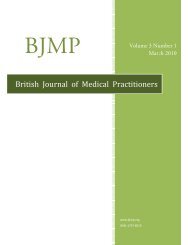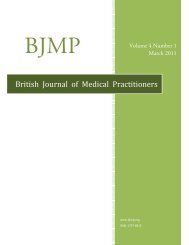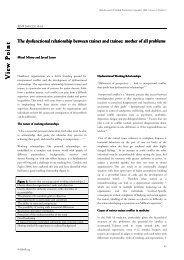R esearch A rticle - British Journal of Medical Practitioners
R esearch A rticle - British Journal of Medical Practitioners
R esearch A rticle - British Journal of Medical Practitioners
You also want an ePaper? Increase the reach of your titles
YUMPU automatically turns print PDFs into web optimized ePapers that Google loves.
<strong>British</strong> <strong>Journal</strong> <strong>of</strong> <strong>Medical</strong> <strong>Practitioners</strong>, March 2013, Volume 6, Number 1<br />
therapy. The incidence <strong>of</strong> hyponatremia secondary to<br />
carbamazepine therapy ranges between 4.8 and 40 % depending<br />
on the population studied 10,11 . In most cases, hyponatremia is<br />
asymptomatic and continuation <strong>of</strong> the carbamazepine use is<br />
possible whilst a close eye is kept on the plasma sodium level 10 .<br />
In rare occasions hyponatremia is symptomatic and<br />
discontinuation <strong>of</strong> carbamazepine is warranted. Administration<br />
<strong>of</strong> demeclocycline to normalise the sodium level was suggested<br />
by some authors. 12 However, the long term use <strong>of</strong><br />
demeclocycline is associated with several complications and this<br />
approach is hardly a standard practice.<br />
Clinicians <strong>of</strong>ten face a dilemma when carbamazepine is the only<br />
agent able to control a specific clinical problem. With many<br />
antiepileptics available, it is unusual to face such a problem in<br />
epileptic patients. Trigeminal neuralgia on the other hand can<br />
be extremely difficult to control and carbamazepine was found<br />
to have a unique ability to manage such unpleasant condition<br />
even before its antiepileptic effects were noticed on 1962 13 .<br />
Eslicarbazepine is promoted as an alternative to carbamazepine<br />
when side effects occurs on otherwise responsive patients to its<br />
favourable antiepileptic effects 14 . Hyponatremia is rare in<br />
eslacarbazepine users with only an incidence <strong>of</strong> less than 1% in<br />
the small populations studied 15,16 . Frequency <strong>of</strong> hyponatraemia<br />
increased with increasing eslicarbazepine dose. In patients with<br />
pre-existing renal disease leading to hyponatraemia, or in<br />
patients concomitantly treated with medicinal products which<br />
may themselves lead to hyponatraemia 17 .<br />
Our patient showed the same favourable response to<br />
eslicarbazepine as she experienced with carbamazepine.<br />
However, hyponatremia did not occur with eslicarbazepine<br />
therapy. This enabled our patient to continue with<br />
pharmacological management and avoid surgical interventions.<br />
With the exception <strong>of</strong> epilepsy, no reports are available<br />
commenting on the use <strong>of</strong> eslicarbazepine on the wide range <strong>of</strong><br />
conditions that carbamazepine is traditionally used for such as<br />
mental health problems and neuropathic pain. When patients<br />
are well controlled on carbamazepine whatever the indication is,<br />
the occurrence <strong>of</strong> side effects such as hyponatremia is <strong>of</strong>ten<br />
managed by an automatic replacement with another agent. We<br />
feel that in such patients a therapeutic trial <strong>of</strong> eslicarbazepine<br />
might be appropriate especially if the control on carbamazepine<br />
was robust or if the benefits <strong>of</strong> carbamazepine therapy were<br />
clearly superior to other pharmacological agents potentially<br />
useful for the targeted clinical condition.<br />
Competing Interests<br />
None declared<br />
Author Details<br />
TAREK A-Z K GABER, FRCP (London), Consultant in Neurological<br />
Rehabilitation, Wrightington, Wigan and Leigh NHS Foundation Trust, UK.<br />
MYINT MYINT KYU, MRCP, Specialist Registrar in Rehabilitation Medicine,<br />
North West <strong>of</strong> England Deanery, UK. WAH WAH OO, MRCP, Specialist<br />
Registrar in Rehabilitation Medicine, North West <strong>of</strong> England Deanery, UK.<br />
CORRESSPONDENCE: DR TAREK GABER, Consultant in Neurological<br />
Rehabilitation, Leigh Infirmary, Leigh, Lancs. WN7 3NF, UK.<br />
Email: tgaber@doctors.net.uk<br />
REFERENCES<br />
1. Hooge JP, Redekop WK. Trigeminal Neuralgia in Multiple Sclerosis.<br />
Neurology 1995; 45: 1294-6<br />
2. Brisman R. Trigeminal neuralgia and Multiple Sclerosis. Arch Neurol.<br />
1987; 44(4):379-381.<br />
3. Zvartau-Hind M, Din MU, Gilani A, Lisak RP, Khan OA. Topiramate<br />
relieves refractory trigeminal neuralgia in MS patients. Neurology 2000;<br />
55(10):1587-8.<br />
4. Gilron I, Booker SL, Rowan JS, Max MB. Topiramate in trigeminal<br />
neuralgia: a randomized, placebo-controlled multiple crossover pilot<br />
study. Clin Neuropharmacol 2001; 24(2):109-12<br />
5. Khan OA. Gabapentin relieves trigeminal neuralgia in multiple sclerosis<br />
patients. Neurology 1998; 51(2):611-4.<br />
6. Leandri M, Lundardi G, Inglese M, Messmer-Uccelli M, Mancardi GL,<br />
Gottlieb A, Solaro C. Lamotrigine in trigeminal neuralgia secondary to<br />
multiple sclerosis. J Neurol 2000; 247(7):556-8.<br />
7. Cheng JS, Sanchez-Mejia RO, Limbo M, Ward MM, Barbaro NM.<br />
Management <strong>of</strong> medically refractory traigeminal neuralgia in patients<br />
with multiple sclerosis. Neurosurg Focus 2005; 18(5):e13<br />
8. Gronseth G, Cruccu G, Arg<strong>of</strong>f C, Brainin M, Burchiel K, Nurmikko<br />
T, Zakrzewska JM; American Academy <strong>of</strong> Neurology Society;<br />
European Federation <strong>of</strong> Neurological Society. AAN-EFNS guidelines<br />
on trigeminal neuralgia management. Eur J Neur. 2008<br />
Oct;15(10):1013-28.<br />
9. Wiffen P, McQuay H, Carroll D, Jadad A, Moore A. Anticonvulsant<br />
drugs for acute and chronic pain. Cochrane Database Syst Rev.<br />
2000;(2):CD001133.<br />
10. Dong X, Leppik IE, White J, Rarick J. Hyponatremia from<br />
Oxcarbazepine and Carbamazepine. Neurology 2005; 65(12): 1976-<br />
1978<br />
11. Van Amelsvoort TH, Bakshi R, Devaux CB, Schwabe S. Hyponatremia<br />
Associated with Carbamazepine and Oxcarbazepine Therapy: A Review.<br />
Epilepsia 1994; 35(1): 181-188<br />
12. Brewerton TD, Jackson CW. Prophylaxis <strong>of</strong> carbamazepine-induced<br />
hyponatremia by demeclocycline in six patients. The <strong>Journal</strong> <strong>of</strong> Clinical<br />
Psychiatry 1994; 55(6): 249-251<br />
13. Schindler W, Häfliger F. Über Derivate des Iminodibenzyl. Helvetica<br />
Chimica Acta 1954; 37 (2): 472–83.<br />
14. Elger C et al Efficacy & Safety <strong>of</strong> eslicarbazepine acetate as adjunctive<br />
treatment in adults with refractory partial-onset seizures: A randomised,<br />
double-blind, placebo-controlled, parallel group, phase III study,<br />
Epilepsia, 2009; 50; (3): 453-63.<br />
15. Versavel M et al, An investigation <strong>of</strong> the effects <strong>of</strong> eslicarbazepine<br />
acetate on hyponatraemia: A pooled analysis <strong>of</strong> three double-blind<br />
phase III clinical studies. Poster presented AES Annual Meeting Dec<br />
2009, San Antonio<br />
16. Nunes T et al. Incidence <strong>of</strong> rash and hyponatraemia in adult patients<br />
with refractory partial seizures treated with adjunctive eslicarbazepine<br />
acetate: Results from three phase III studies and 1-year open-label<br />
extensions. Poster presented at ECE Annual Meeting June 2010,<br />
Rhodes.<br />
17. Gil-Nagel A et al, Efficacy and safety <strong>of</strong> 800 mg and 1200 mg<br />
eslicarbazepine acetate as adjunctive treatment in adults with refractory<br />
partial-onset seizures, Acta Neurol Scand, 2009; 120: 281-287.<br />
BJMP.org<br />
33







